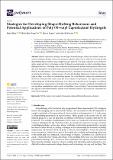| dc.contributor.author | Zhou, Shuo | |
| dc.contributor.author | Hieng, Billy Shu Hieng | |
| dc.contributor.author | Zhuo, Shuo | |
| dc.date.accessioned | 2023-05-04T10:12:41Z | |
| dc.date.available | 2023-05-04T10:12:41Z | |
| dc.date.issued | 2023-03-18 | |
| dc.identifier.citation | Zhuo, S.; Shu Hieng Tie, B.; Keane, G.; Geever, L.M. Strategies for developing shape-shifting behaviours and potential applications of poly(N-vinyl Caprolactam) hydrogels. Polymers 2023, 15, 1511. https://doi.org/ 10.3390/polym15061511 | en_US |
| dc.identifier.uri | https://research.thea.ie/handle/20.500.12065/4500 | |
| dc.description.abstract | Stimuli-responsive hydrogels are one type of smart hydrogel, which can expand/contract in
water according to changes in the surrounding environment. However, it is difficult to develop flexible
shapeshifting behaviours by using a single hydrogel material. This study exploited a new method to
utilise single and bilayer structures to allow hydrogel-based materials to exhibit controllable shapeshifting
behaviours. Although other studies have demonstrated similar transformation behaviours,
this is the first report of such smart materials developed using photopolymerised N-vinyl caprolactam
(NVCL)-based polymers. Our contribution provides a straightforward method in the fabrication
of deformable structures. In the presence of water, the bending behaviours (vertex-to-vertex and
edge-to-edge) were achieved in monolayer squares. By controlling the content and combination of
the NVCL solutions with elastic resin, the bilayer strips were prepared. The expected reversible
self-bending and self-helixing behaviours were achieved in specific types of samples. In addition,
by limiting the expansion time of the bilayer, the layered flower samples exhibited predictable selfcurving
shape transformation behaviour in at least three cycles of testing. These structures displayed
the capacity of self-transformation, and the value and functionality of the produced components are
reflected in this paper. | en_US |
| dc.format | PDF | en_US |
| dc.language.iso | eng | en_US |
| dc.publisher | MDPI | en_US |
| dc.relation.ispartof | Polymers | en_US |
| dc.rights | Attribution 3.0 United States | * |
| dc.rights.uri | http://creativecommons.org/licenses/by/3.0/us/ | * |
| dc.subject | NVCL | en_US |
| dc.subject | Temperature sensitive hydrogels | en_US |
| dc.subject | Shape-shifting behaviours | en_US |
| dc.subject | Actuation | en_US |
| dc.title | Strategies for developing shape-shifting behaviours and potential applications of poly(N-vinyl Caprolactam) hydrogels | en_US |
| dc.type | info:eu-repo/semantics/article | en_US |
| dc.contributor.affiliation | Technological University of the Shannon: Midlands Midwest | en_US |
| dc.contributor.sponsor | Technological University of the Shannon: Midlands Midwest, Presidents Seed Fund (PSF) | en_US |
| dc.description.peerreview | yes | en_US |
| dc.identifier.doi | 10.3390/polym15061511 | en_US |
| dc.identifier.eissn | 2073-4360 | |
| dc.identifier.orcid | https://orcid.org/0000-0003-1728-1374 | en_US |
| dc.identifier.orcid | https://orcid.org/0000-0001-6923-4807 | en_US |
| dc.identifier.orcid | https://orcid.org/0000-0001-5481-3080 | en_US |
| dc.identifier.volume | 15 | en_US |
| dc.subject.department | PRISM: Polymer, Recycling, Industrial, Sustainability and Manufacturing Institute: TUS Midlands | en_US |
| dc.type.version | info:eu-repo/semantics/publishedVersion | en_US |


